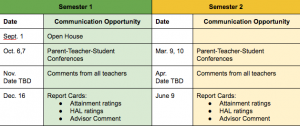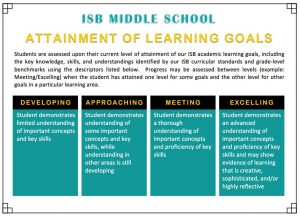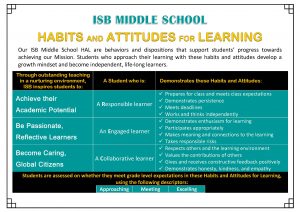By Cindy Plantecoste
At ISB, we take every opportunity to work in partnership with parents to support your children in their learning and development. To this end, we provide a variety of pathways to keep you informed about what your child is learning, the environment in which it takes place, and about how your child approaches his/her learning. In the MS we formally communicate with parents through Open House, Parent-Teacher-Student conferences, written comments, and report cards.
We have built the following timeline for communication to ensure that you have regular opportunities to monitor the progress of your child in his/her academic subjects as well as the habits and attitudes that your child exhibits that contribute to learning. Our goal is that you and your child will not encounter any surprises over the course of the year related to how your child’s progress.
Open house is an event that allows you to meet your child’s teachers, learn about his/her courses, and experience the learning environment that teachers have created in their classrooms. Teachers will share information about the course content, assessment, and how and when to contact them, should you have any questions.
Parent-teacher-student conferences allow you to have one on one time with each of your child’s teachers to discuss progress towards learning goals, and the way in which your child is approaching his/her learning. We strongly encourage students to actively participate in these conferences and to be advocates for their pathway forward in their learning.
About a month after conferences, teachers will write comments for each of their students, pointing out areas of growth that have occurred since the conferences and areas that may still need attention.
At the end of each semester, your child will receive a Report Card, which will include a comment from your child’s advisor.
In the MS at ISB, our report cards reflect that fact that we use a standards-based recording and reporting system. Simply put, this means that we report on your child progress towards our identified learning goals separately from how your child is approaching his/her learning. We intentionally separate these two components to provide you with the clearest picture of your child’s progress and of your child as a learner.
At ISB, we design our curriculum around standards (what we want students to know, understand, be able to do, and apply to new contexts for each subject area). To provide clear communication to families and students, our reporting systems are aligned to these learning goals. We ‘chunk’ learning goals into reporting categories that are easy to understand, and that provide enough detail to show strengths and as well as areas for growth within a given subject area. For example, the English curriculum is based around the Common Core Standards. When we report on progress towards these standards, we use the reporting categories of Reading, Writing, Speaking, Listening, and Language. In this way, you can easily see the particular areas in English where your child may be excelling or in need of extra support. On the report card, these reporting categories for each subject fall under the section called: Attainment of Learning Goals. This provides the parent and learner specific information about learning, rather than a number, percentage, or letter “average,” which provides no specific information.
Here is the graphic that explains how we rate students’ achievement of learning goals.
To further look at our example from English class, and using our descriptors from the graphic above, a child’s progress in English could look like this:
- Reading: (M) Meeting
- Writing: (M) Meeting
- Speaking: (E) Excelling
- Listening: (A) Approaching
- Language: (M) Meeting
Another major goal for our report card is to clearly communicate how your child approaches his/her learning (HAL – Habits and Attitudes for Learning). Our ISB MS HAL are behaviors and dispositions that support students’ progress towards achieving our Mission. Students who approach their learning with these habits and attitudes develop a growth mindset and become independent, lifelong learners.
Here is the graphic that explains how we rate students’ HAL.
Should you have any questions that you would like to discuss, or if you would like to learn more about standards-based grading and reporting, please feel free to drop by the office, or schedule an appointment to meet with me.
Cindy Plantecoste
Middle School Dean of Academics



